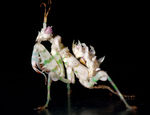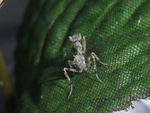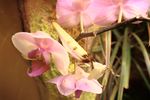Flower mantis
| Flower mantis |
|---|
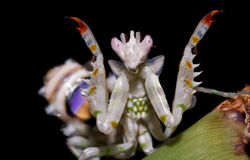
|
| Scientific Classification |
|
| Genera |
|
Subfamily Acromantinae
Subfamily Epaphroditinae Subfamily Hymenopodinae
Subfamily Oxypilinae |
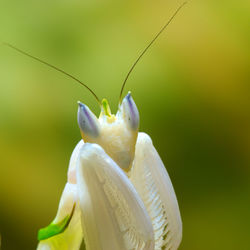
|
| Close up of female Orchid Mantis head |
The flower mantis are any of the species of mantids belonging to the taxonomic family Hymenopodidae. The first time a flower mantis was “discovered” was when an Australian journalist visited Indonesia and returned with stories of a plant that trapped insects in its petals and ate them. While the journalist was incorrect in assuming this beautiful insect was a flower, he made a mistake that many bugs also make. [2] These delicate creatures range from absolutely stunning to look at, to terrifyingly ferocious looking, seemingly like aliens or perhaps some mutant, insect and plant hybrids. These are the Flower Mantises, scientific family Hymenopodidae, and are most famous for their near identical mimicry of different flowers.
Body Design
The Flower Mantis has an incredibly unique body design. Like all Mantises, they have an extended prothorax that allows them to see over their shoulder when watching an insect without alerting the prey to its presence. This body part also helps when they are eating their prey which is trapped between their predatory forelegs. [3] Mantises Have triangular heads with bulbous compound eyes [4] and generally has three eyespots between the compound eyes. They have powerful predatory forelegs used to snatch prey and hold prey until eaten, [5] and two pairs of walking legs.
Female Flower Mantises, generally around 6 cm. in length, are much larger than males, which are generally only 2.5 to 3 cm. long. However, a male’s body contains eight body segments, while a females only contains six. Both Males and females are able to fly, and males are quite good at doing so. The Orchid Mantis resembles an orchid, with its walking legs mimicking orchid petals. The majority of these Mantises are white, though there are purple and pink ones as well.[6]
Life Cycle
A female mantis secretes a lightweight, protective substance to form a type of case for her eggs, which she essentially encases inside of the case before it hardens. [3] The pod, called an Ootheca,[4] establishes a line of defense against the environment and camouflages the eggs from hungry eyes. [3] An Ootheca generally contains anywhere from 30 to 300 eggs within its walls.[4] When the eggs hatch in spring, [5] there is an exodus from the protection of the egg case into the world. The juvenile mantises quickly leave the safety of the pod and take off in all directions. Many of the little mantises do not make it, usually being caught and eaten by ants and spiders and other predators. Despite the reduction in numbers, the surviving population soon become formidable predators themselves.[3]
A young female mantis, undergoing incomplete metamorphosis, [5] generally molts seven times, and lives about eight months. Males, also undergoing incomplete metamorphosis, only molt five times in general, mature much faster than females and live for around six months. Two weeks after her final molt, the female mantis is ready to mate. [6] In several species, it is essential that the female eat the male’s head during the mating process. [4] This is because the male is unable to pass on his sperm until the head has been detached from his body. [3] His body is equipped to finish mating with the female, and is then eaten as well. [4] Since the male is unlikely to find more than one female in advance to being eaten by some other predator, a female is incredibly fertile. A female only mates once as well, [3] although they are not devoured by their partner, and are able to produce as many as 22 Ootheca, depending on the nutrients available to them. The female dies about two weeks after laying her eggs. [4]
Ecology
The Flower Mantis, with around 1,800 different species, are found in the coast of East Africa near the coast and South and East Asia. They are incredibly skilled hunters and eat many different insects, and are generally welcomed by gardeners because they eat the insects that harm their gardens. [4] They help control populations from getting out of control, but cannot keep up with some of the insect's reproduction rates. However, the mantises are known to also eat other helpful insect as well. [7] Nymphs consume small insects while adults eat anything they are able to catch, [6] some mantises are even known to eat small birds and reptiles when given the chance. [4] Most of these hunters spend their time hunting in the foliage waiting for their food, some species hunt along the forest floor and in the decaying leaves. A mantis, if it has already caught one meal, and another comes along that is not too large, will catch the second meal in its free arm and save the second until it is done with the first. [3]
A mantis will generally spend its time among the vegetation that it is disguised as, tall grasses, or low, dense vegetation, [4] as well as bright flowers, branches and twigs. They will also be found where prey is present. Their concealment methods also greatly boost their predacious abilities. [7] While mantises have the ability to fly, they generally only do so at night. However, this puts them at risk to another predator not found during the daytime: bats. Despite being part of the bats food source, a few species have adapted by using echolocation, the same thing the bats are using to hunt them with, to navigate for themselves. They also employ echolocation to sense bats and basically hesitate or stall their flight and drop below the bats radar and escape. [3] In late summer, however, adults have been known to be attracted to black lights while flying and may fly into them. [7]
Mimicry
A flower mantis clearly utilizes mimicry in its life. The flower mantises are hunted by bats and other predators, so they are colored to match parts of plants such as flowers, twigs, leave and even grass to hide. Some species only keep its camouflage while they are nymphs, while others keep it their entire lives. While many plants and animals use mimicry solely for protection, a flower mantis also uses it for predation. [3] However, only in recent times have scientist’s been able to confirm the question, are bugs really fooled by a flower mantis’s gimmicks? Multiple scientists from Macquarie University in Australia and University of Auckland in New Zealand traveled to Malaysia, to find out the truth of the matter. To their surprise, they found that in the viewpoint of a bug, the flower mantis seems nearly identical to multiple species of flowers in the region. In fact, they discovered that bugs were more attracted to the mantis than the original flower! “The orchid mantises we observed were not hiding amongst flowers, but were sitting on their own against a backdrop of green vegetation,” James O’Hanlon, one of the scientists from Macquarie University, said. “Thus, it was the body of the mantis itself that was attracting the pollinators, and not any flowers in its vicinity.” [2] Each mantis will allow itself to blend into its environment, hiding from both quarry and predators. Many species of Flower Mantis are excellent at camouflage, and will sit and allow prey to come to them, while others will go in search of food and hunt it down, like the Nigerian Flower Mantis. [8]
The mimicry itself can vary greatly. Some mantises have been found to mimic multiple characteristics from multiple flowers in their habitat [2] and others mimic a specific plant. However, all mimic the flowers they are surrounded by. The Orchid mantises legs, head and body resemble petals, and are usually colored white and pink and seems to look almost identical to a flower. A Spiny Flower Mantis, on the other hand, is dark and has a golden spiral on his farthest set of wings. A Thistle Mantis is a beige color, with adults having light green veins on its wings and stripes on its body, and relatively bright orange front legs with blue spots to startle any predators. Nigerian Flower Mantises are green and have incredible round, blue eyes, while Indian Flower Mantises are creamy-white colored with green and brown spots on is back and striped legs bearing the colors brown and green. A Jeweled Flower Mantis has a green and white abdomen and is relatively dull colored.[8]
Video
Spiny Flower Mantis catching its food.
Gallery
References
- ↑ Hymenopodidae WikiSpecies. Web. Last updated January 24, 2013.
- ↑ 2.0 2.1 2.2 Bates, Mary. National_Geographic National-Geographic. Web. Posted September 25, 2013.
- ↑ 3.0 3.1 3.2 3.3 3.4 3.5 3.6 3.7 3.8 .Unknown AuthorPraying Mantids (Mantodea) Earth Life. web. Accessed December 17, 2013.
- ↑ 4.0 4.1 4.2 4.3 4.4 4.5 4.6 4.7 4.8 Deatz, George. Praying mantis or praying mantid (Mantodea) Friends of the Garden. Web. Posted on October 6, 2013.
- ↑ 5.0 5.1 5.2 Eiseman, Charley. Order Mantodea - Mantids Bug Guide. Web. Last Updated 18 September, 2013.
- ↑ 6.0 6.1 6.2 Unknown Author. Malaysian Orchid Mantis Waza. Web. Accessed December 17, 2013.
- ↑ 7.0 7.1 7.2 Unknown Author Mantid_Info Insect-ed-.Arizona. Web. Accessed January 13, 2014.
- ↑ 8.0 8.1 Unknown author. Amazing_List Amazing-List. Web. Posted March 3, 2013.
